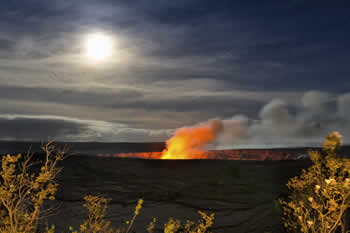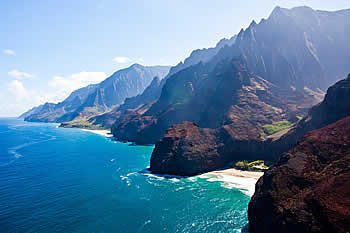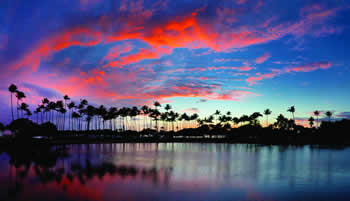Sessions
Symposium
S1. Biogeochemistry of Sedimentary Carbonates: A Symposium Dedicated to Bob Berner and John Morse.
Fred T. Mackenzie, Univ. of Hawai‘i, fredm soest.hawaii.edu; Jane Schoonmaker, Univ. of Hawai‘i, jane
soest.hawaii.edu; Jane Schoonmaker, Univ. of Hawai‘i, jane soest.hawaii.edu.
soest.hawaii.edu.
Description: The session encourages papers dealing with the fundamentals of experimental, observational, and theoretical carbonate biogeochemistry and their application to problems in Earth history, including the evolution of atmospheric CO2, the marine carbon system and ocean acidification, and carbonate sediments as indicators of environmental change.

Halema‘uma‘u Crater, Big Island.
Photo by Ethan Tweedie.
Theme Sessions
T1. Cordilleran Magmatic Forensics—Insights from the Igneous, Metamorphic, and Sedimentary Record.
Shanaka de Silva, Oregon State Univ., desilvas geo.oregonstate.edu; Rita Economos, Southern Methodist Univ., rita.economos
geo.oregonstate.edu; Rita Economos, Southern Methodist Univ., rita.economos gmail.com; Nancy Riggs, Northern Arizona Univ., nancy.riggs
gmail.com; Nancy Riggs, Northern Arizona Univ., nancy.riggs nau.edu; Andy Barth, Indiana Univ.–Purdue Univ. Indianapolis, ibsz100
nau.edu; Andy Barth, Indiana Univ.–Purdue Univ. Indianapolis, ibsz100 iupui.edu.
iupui.edu.
Description: Igneous activity in cordilleran orogens is inexorably linked with tectonic development and is a critical component of continental crustal evolution and construction. We invite talks that explore the character, origin and timing of magmatism and their links to the tectonic evolution of cordilleran orogens from a multi-disciplinary perspective.
T2. Structural Geology and Tectonics of the Western United States.
Stephen Martel, Univ. of Hawai‘i, smartel hawaii.edu; Ann Egger, Central Washington Univ., annegger
hawaii.edu; Ann Egger, Central Washington Univ., annegger geology.cwu.edu.
geology.cwu.edu.
Description: The session encourages papers dealing with the structural geology and tectonics, especially in the western part of the continental United States, the seafloor of the eastern Pacific Ocean, and Hawai‘i.
T3. Magmatism and Orogenesis in the Sedimentary Record.
Matthew McKay, Missouri State Univ., matthewmckay missouristate.edu; William Jackson, Univ. of Alabama/Geological Survey of Alabama, wjackson
missouristate.edu; William Jackson, Univ. of Alabama/Geological Survey of Alabama, wjackson gsa.state.al.us; Keith Gray, Wichita State Univ., k.gray
gsa.state.al.us; Keith Gray, Wichita State Univ., k.gray wichita.edu.
wichita.edu.
Description: This session will explore the representation of magmatism and orogenesis in the sedimentary record. We encourage contributions that present innovative approaches for interpreting tectonic events using sedimentary strata, with topics including field mapping, structural analysis, sequence/seismic stratigraphy, paleoseismic features, tephrochronology, and quantitative analysis (geochronology, geochemistry, etc.).
T4. The Pacific Plate through Geologic Time.
Paul Wessel, Univ. of Hawai‘i, pwessel hawaii.edu; Simon E. Williams, EarthByte, Univ. of Sydney, Australia, simon.williams
hawaii.edu; Simon E. Williams, EarthByte, Univ. of Sydney, Australia, simon.williams sydney.edu.au.
sydney.edu.au.
Description: The Pacific is the Earth’s largest tectonic plate, yet the absence of a continent means its evolution is poorly constrained. The “ring of fire” and the Hawaii-Emperor Bend are consequences of its evolution and interaction with neighboring plates. This session welcomes submissions on topics related to the evolution of the Pacific plate.

Nā Pali Coast, Kaua‘i.
Courtesy Hawaii Tourism Authorty, Tor Johnson.
T5. Internal Structure, Active Deformation, and Mechanics of Accretionary Prisms and Orogenic Wedges.
Garrett Ito, Univ. of Hawai‘i, gito@hawaii.edu; Gregory F. Moore, Univ. of Hawai‘i, gmoore@hawaii.edu; James Foster, Univ. of Hawai‘i, jfoster@soest.hawaii.edu.
Description: Submarine accretionary prisms and subaerial orogenic wedges represent Earth’s most dramatic tectonic phenomena and are associated with devastating natural hazards. This session brings together geophysical and geodetic studies of the active deformation and internal structures, geologic studies of the lithology and rheological properties, as well as modeling studies of the mechanics of these convergent systems.
T6. Magmatic Processes and Sources for Hotspot Volcanoes.
Michael Garcia, Univ. of Hawai‘i, mogarcia@hawaii.edu; Jasper Konter, Univ. of Hawai‘i, jkonter@hawaii.edu.
Description: Contributions that address the nature of the sources and the processes that create and modify magmas erupted at hotspot volcanoes are encouraged.
T7. Origin and Evolution of Continental and Oceanic-Arc Magmas.
Michael Garcia, Univ. of Hawai‘i, mogarcia@hawaii.edu.
Description: Understanding the origin and evolution of magmas related to circum-Pacific arc volcanism is the theme of this session. Presentations that address all aspects of arc volcanism are welcome, especially field studies, petrology and geochemistry.
T8. Explosive Volcanism.
Bruce. F. Houghton, Univ. of Hawai‘i, bhought@soest.hawaii.edu; Don Swanson, USGS, Hawaiian Volcano Observatory; donswan@usgs.gov; Sarah Fagents, Univ. of Hawai‘i, fagents@hawaii.edu.
Description: Explosive eruptions are unusual amongst natural hazard events for their complexity, i.e., the number and diversity of hazard types that may operate simultaneously but on very different temporal and spatial scales. We seek here contributions on both the fundamental processes of explosive eruptions but also risks and threats to communities.
T9.Volcanic Impacts.
Costanza Bonadonna, Univ. of Geneva, Costanza.Bonadonna@unige.ch; Sebastien Biasse, Univ. of Hawai‘i, sbiasse@hawaii.edu; Susanna Jenkins, Earth Observatory of Singapore, susanna.jenkins@gmail.com; Thomas Wilson, Univ. of Canterbury, New Zealand, thomas.wilson@canterbury.ac.nz; Christina Neal, USGS, Hawaiian Volcano Observatory, tneal@usgs.gov.
Description: Volcanic phenomena (e.g. ash dispersal and sedimentation, pyroclastic density currents, lahars, lava flows) are associated with a range of impacts on urban, agricultural and natural systems at different temporal and spatial scales. This symposium explores multidisciplinary approaches for the characterization and assessment of all types of volcanic impacts.

Ala Moana Beach Park.
T10. Hazards and Hazard Communication Related to the Active Volcanoes of Hawai‘i.
Christina Neal, USGS, Hawaiian Volcano Observatory, tneal@usgs.gov; Janet Babb, USGS, Hawaiian Volcano Observatory, jbabb@usgs.gov.
Description: During 33-plus years of nearly continuous eruption and unrest, scientific investigations have improved our understanding of the hazards posed by Hawaiian volcanoes. This session seeks contributions detailing new insights on the nature and impacts of volcano hazards in Hawai‘i and the techniques of communicating those hazards to at-risk residents.
T11.Submarine Volcanism in Hawai‘i and Elsewhere.
Ken Rubin, Univ. of Hawai‘i, krubin@hawaii.edu; Sam Mitchell, Univ. of Hawai‘i, samjm@hawaii.edu.
Description: Most of Earth's volcanism occurs in the oceans, where eruptions and eruption deposits can be difficult to study, yet research using submersible, mapping robots, remote detection, and shore-based sample analysis are leading to leaps in understanding. Submissions on all forms of submarine (or subaqueous) volcanism and studies by any methods are encouraged.
T12. Fluid Flow, Submarine Seeps, and Gas Hydrate Systems: Implications for the Global Carbon Cycle and Seafloor Stability.
Katie Taladay, Univ. of Hawai‘i, taladay@hawaii.edu; Hitoshi Tomaru, Chiba Univ., tomaru@chiba-u.jp.
Description: This session focuses on the latest advancements in our understanding of subsurface fluid flow, the dynamic nature of seep systems, and the relationship between fluid flow and gas hydrate occurrence. We invite contributions from recent field and laboratory results, and discussions regarding the implications for carbon cycling and/or potential geohazards.
T13. Marine Minerals, Key Resources for the Twenty-First Century.
James R. Hein, USGS, jhein@usgs.gov; Kira Mizell, USGS, kmizell@usgs.gov; Amy Gartman, USGS, agartman@usgs.gov.
Description: Global metal markets, establishment of regulatory frameworks, and technology advancements are driving rapidly accelerating international deep-ocean mining activities. This session addresses ferromanganese crusts and nodules, hydrothermal manganese and iron, seafloor massive sulfides, phosphorite, REE-rich muds, other deep-ocean/shallow-marine mineral deposits, and comparisons with land-based deposits.
T14. Advances in Geothermal Resource Investigation.
Pete Stelling, Western Washington Univ., pete.stelling@wwu.edu; Nick Hinz, Univ. of Nevada-Reno; nhinz@unr.edu; Nicole Lautze, Univ. of Hawai‘i, nlautze@soest.hawaii.edu; Garrett Ito, Univ. of Hawai‘i, gito@hawaii.edu.
Description: Exploration, development and support of geothermal energy is entering a period of resurgence in the western U.S. and around the world. We welcome contributions pertaining to any geothermal and hydrothermal location or topic, including exploration updates, technological breakthroughs, modeling results and more.
T15. Mineral Physics Research Aspects Related to Deep Earth’s Interior and Phenomena.
Murli Manghnani, Univ. of Hawai‘i, murli@soest.hawaii.edu; Bin Chen, Univ. of Hawai‘i, binchen@hawaii.edu.
Description: High P-T mineral physics is vital to understanding the formation, evolution, crystal-chemical mineralogy, thermal state, and dynamics of the Earth and planetary interiors. Advances in experimental techniques, seismology, and modeling have improved our knowledge regarding thermal state, elasticity, crystal-chemistry, melting, phase transitions, rheology in the mantle; and the core-mantle interactions.
T16. New Developments in the Geology and Geochemistry of Mars.
Jim Bell, Arizona State Univ., jim.bell@asu.edu; Scott Rowland, Univ. of Hawai‘i, scott@soest.hawaii.edu.
Description: This session will highlight spectacular recent advances in our understanding of the geology and geochemistry of Mars. Orbiters, landers, and rovers are almost daily providing new views, and new data, that paint a picture of Mars as a world with a complex volcanic, impact, tectonic, and fluvial history.
T17. Volcanism across the Solar System.
Sarah A. Fagents, Univ. of Hawai‘i, fagents@hawaii.edu; Rosaly Lopes, Jet Propulsion Laboratory, rosaly.m.lopes-gautier@jpl.nasa.gov.
Description: This session will focus on extraterrestrial volcanism, from our neighboring silicate planets to the ice-rich bodies of the outer solar system. We encourage contributions discussing new data and observations, recent modeling developments, novel techniques, field analog studies, integration of diverse data sets, and comparative planetary studies.
T18. Deposition and Diagenesis of Volcaniclastic Sediments on Earth and Mars.
Juergen Schieber, Indiana Univ., jschiebe@indiana.edu; Ken Edgett, Malin Space Science Systems, edgett@msss.com; David Bish, Indiana Univ., bish@indiana.edu.
Description: Our goal is to bring together researchers investigating deposition and post-depositional alteration of terrestrial volcaniclastic sediments with those working on Martian sediments and sedimentary rock. To help with the science return from Mars Rover data, of particular interest are mafic to intermediate sediments, sedimentary rocks, and their diagenesis.
T19. Mars on Earth: Understanding Mars through Earth Surface Processes.
Robert A. Craddock, Center for Earth and Planetary Studies, Smithsonian Institution, craddockb@si.edu; Jacob E. Bleacher, Planetary Geodynamics Lab, NASA Goddard Space Flight Center, jacob.e.bleacher@nasa.gov; Christopher Hamilton, Univ. of Arizona, hamilton@lpl.arizona.edu.
Description: Analog sites on Earth are useful for understanding geologic features on Mars, testing technology for future manned and unmanned missions, and for evaluating potential past and present conditions for astrobiology. Results from ongoing analog field studies, particularly those in Hawai‘i, will be presented.
T20. Paleomagnetism, Rock Magnetism, and Archaeomagnetism.
Emilio Herrero-Bervera, Univ. of Hawai‘i, herrero@soest.hawaii.edu; Evdokia Tema, Univ. degli Studi di Torino, Italy, evdokia.tema@unito.it.
Description: By observing the fluctuations in direction and intensity of the Earth’s magnetic field through time, we increase our understanding of the generation of the geomagnetic field. We invite contributions focused on the acquisition of new directional and archaeointensity paleomagnetic data for the last 500 Ma, including data from lava flows and sedimentary records.
T21. Geoarchaeology in Hawai‘i and Oceania.
Floyd W. McCoy, Univ. of Hawai‘i–Windward, fmccoy@hawaii.edu; Alex Morrison, International Archaeology LLC, alexmorr@hawaii.edu; Alex Parisky, Univ. of Hawai‘i–Windward, parisky@hawaii.edu.
Description: Geoarchaeology finds special significance for deciphering physical processes notable impact on anthropogenic cultures in both in prehistoric and historic times – these are critical for understanding our future. This merge of geology and archaeology, combined with cultural factors (legends, chants, etc.), defines this session with focus on Hawai‘i and the Pacific Basin.
T22. Cenozoic Paleoecology, Paleogeography, and Evolutionary History of Pacific Marine Life.
Steven M. Stanley, Univ. of Hawai‘i, stevenst@hawaii.edu; Sonia J. Rowley, Univ. of Hawai‘i, srowley@hawaii.edu.
Description: This session will focus on all environmental and evolutionary aspects of the Cenozoic history of marine life in the Pacific Ocean at all temporal and spatial scales. It will include studies employing evidence from paleoceanography as well as studies employing evidence from the modern fauna.
T23. Ocean Acidification: Past, Present, and Future: A Session to Honor the Work and Career of Fred T. Mackenzie.
Michael Guidry, Univ. of Hawai‘i, guidry@hawaii.edu; Eric De Carlo, Univ. of Hawai‘i, edecarlo@soest.hawaii.edu.
Description: The focus of this session is on ocean acidification from perspectives of the distant past, present day, and into the future as a way to celebrate and honor the profound career of Dr. Fred T. Mackenzie.
T24. Modeling Past Climates.
Axel Timmermann, IPRC, SOEST, Univ. of Hawai‘i, axel@hawaii.edu; Tobias Friedrich, Univ. of Hawai‘i, tobiasf@hawaii.edu, Fabian Schloesser, Univ. of Hawai‘i, schloess@gmail.com.
Description: Understanding past climate change requires an in-depth understanding of the physical processes that govern earth’s response to external forcings and its internal dynamics. This session is devoted to furthering our understanding of earth system variability during the past 100 million years through a variety of modeling approaches.
T25.Interpreting Holocene Climate from the Geologic Record.
Basil Gomez, Univ. of Hawai‘i, basilg@hawaii.edu.
Description: Rapid climate transitions may be caused by a combination of processes that align to promote cooling or warming of the climate system over centuries or decades. Changes in ice core, lake and marine proxy records can provide a detailed picture of when, how quickly and frequently such climate fluctuations occurred.
T26.Sedimentary Records of Sea Level, Extreme Events, and Coastal Evolution.
Charles Fletcher, Univ. of Hawai‘i, fletcher@soest.hawaii.edu; Bruce Richmond, USGS, brichmond@usgs.gov; Ken Rubin, Univ. of Hawai‘i, krubin@hawaii.edu.
Description: Late Quaternary coastal systems are archives of sea level/climate fluctuations, extreme events (e.g., storms, tsunamis), and geologic framework evolution. Wetlands, beaches, dunes, reefs, insular and continental shelves, and other coastal environments provide records that improve our understanding of these critical environments.
T27. Impacts of Climate Change on Pacific Shores.
Charles Fletcher, Univ. of Hawai‘i, fletcher@soest.hawaii.edu; Patrick Barnard, USGS, pbarnard@usgs.gov.
Description: Climate change is raising sea level and altering historical patterns of storminess, rainfall, and oceanographic and atmospheric processes. These changes will profoundly reshape Pacific coastlines, and threaten human communities and fragile, often endangered, ecosystems. This session invites papers on the latest modeling, observational, and interpretive research on these subjects.
T28. Pacific Coastal Processes.
Charles Fletcher, Univ. of Hawai‘i, fletcher@soest.hawaii.edu; Patrick Barnard, USGS, pbarnard@usgs.gov.
Description: Dynamic physical forces control sediment transport and geomorphology on Pacific Coasts, influencing ecology and human communities. As a result, coastal environments are constantly evolving between perturbed and equilibrium states. This session will highlight papers that describe these processes on beaches, dune, wetlands, cliffed coasts, shallow shelves, reef systems and other coastal environments.
T29.Coastal Hydrology: Impacts of Natural and Anthropogenic Change.
Henrietta Dulai, Univ. of Hawai‘i, hdulaiov@hawaii.edu; Craig R. Glenn, Univ. of Hawai‘i, glenn@soest.hawaii.edu; Peter Swarzenski, International Atomic Energy Agency (Monaco) and USGS, Santa Cruz, P.Swarzenski@iaea.org.
Description: Coastal hydrology studies address topics such as surface water–groundwater interactions, submarine groundwater discharge (SGD), seawater intrusion, and future elevated coastal groundwater levels in diverse systems, including estuaries, wetlands, and coastlines. Such studies provide vital baselines for evaluating anthropogenic impacts, climate change, and sea level rise. This session invites papers in these areas.
T30. Integrated Approaches for Assessing Water Resources.
Aly El-Kadi, Univ. of Hawai‘i, elkadi@hawaii.edu; Stephen S. Anthony, USGS, Pacific Islands Water Science Center, santhony@usgs.gov.
Description: The world faces enormous challenges for water due to competing demands exacerbated by climate change. However, water is only one of a number of vital elements and cannot be considered in isolation. This session will cover water management strategies in relation to legal, cultural, human-health, ecological, and economic considerations.
T31. Engineering Geology of the Western United States.
Stephen Martel, Univ. of Hawai‘i, smartel@hawaii.edu; Scott Burns, Portland State Univ., burnss@pdx.edu; Jerome De Graff, California State Univ. Fresno, jdegraff@csufresno.edu.
Description: The session encourages papers dealing with engineering geology, especially in the western part of the contiguous United States, Alaska, and Hawai‘i.
T32. Applications of Unmanned Aerial Vehicles (UAVs) in the Earth, Ocean, Planetary, and Life Sciences.
Matthew Barbee, Univ. of Hawai‘i, mbarbee@hawaii.edu; Craig R. Glenn, Univ. of Hawai‘i, glenn@soest.hawaii.edu; Nicolas Turner, Univ. of Hawai‘i, nrturner@hawaii.edu; Charles Devaney, International Building Solutions Group, devaneycharles@gmail.com.
Description: Low-altitude Unmanned Aerial Vehicles (UAVs) are low-cost, versatile platforms for monitoring and collecting data from sites that are difficult to approach by other means. The scientific and practical applications of these platforms are varied and only continue to expand. This session invites and convenes workers to >share results, methodologies, and modeling strategies adapted for studies across the Earth, Ocean, Planetary, and Life Sciences.
T33. Undergraduate Research Session (Posters).
Cosponsored by Council on Undergraduate Research, Geosciences Division.
Lydia K. Fox, Univ. of the Pacific, lkfox@pacific.edu; Jeff Marshall, Cal Poly Pomona Univ., marshall@cpp.edu.
Description: This poster session will highlight faculty-mentored research conducted by undergraduate students. All abstracts must be written by the student or students and may have non-student co-authors (although students must present the poster). Topics may include undergraduate research in any discipline of geology or related fields (such as water resources, hydrology, environmental science, or physical geography).

Hanauma Bay, Cristo Viahos